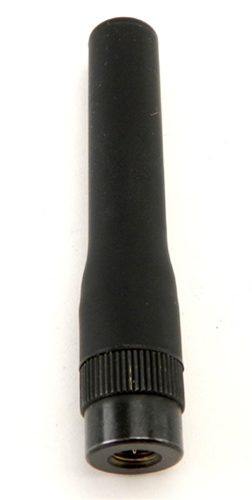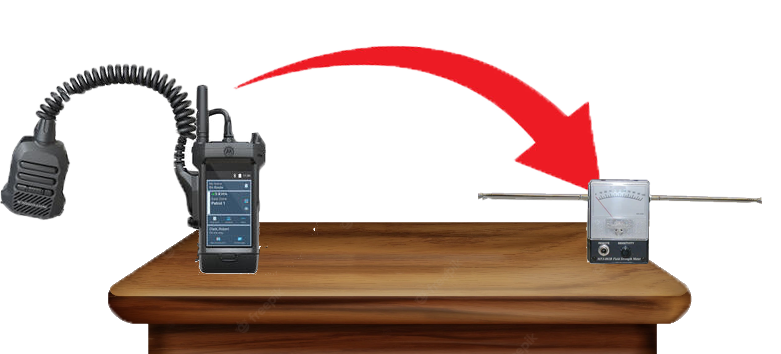
How do you evaluate the performance of an HT’s rubber duck factory original antenna? CBers are only able to grasp SWR. But let’s consider what you are looking for in your analysis. Clearly, what you (and the CBer) are looking for is how much of your transmitter power is being delivered into the atmosphere and how little is being returned to the transmitter. There is a name for this performance specification. It is called “Where the Rubber Meets the Road.” SWR is a good measure of this but what if obtaining an accurate SWR measurement is not practical?
Measuring SWR is nicely facilitated for mag-mounts (that have a ground plane), dipoles, and other antennas where there is a feedline between the transmitter and the antenna. But this is not the case for a rubber duck antenna. The rubber duck antenna attaches directly to the transmitter (your handie-talkie or HT). In measuring a rubber duck’s vector impedance or SWR, the last thing you will want to do is simply attach the rubber duck antenna to the input of a network analyzer or nanoVNA. These, by definition, cannot give accurate readings since rubber duck antennae get their counterpoise from the HT.
Do You Want to Just Go With the Crowd or Be an Innovator?
There is a pervading opinion that original equipment rubber duck antennae are sub-performing devices. The predominant opinion is that for any HT, you will want to buy an aftermarket antenna in order to get the performance out of an HT that you deserve. But what is that thinking based on?
This web page will show how to evaluate your HT rubber duck antenna performance without spending a lot of money on equipment.
A YouTube Video Making a Common Mistake
But first…view the YouTube video below and see if you can identify what the author is doing wrong, which completely and entirely nullifies any conclusions he may try to derive from his observations.
View the YouTube video below and see if you can identify what the author is doing wrong, which completely and entirely nullifies any conclusions he may try to derive from his observations.
Did You Catch His Mistake?
Did you figure it out? The author, in removing the rubber duck from its native environment, removed its counterpoise that it was depending upon from the HT. Any results from this analysis are absolutely, and without equivocation, rendered null and void.
There is a much better way to evaluate an antenna’s performance. This method has a name. It is called finding out where the rubber meets the road.
Equipment
With an RF field strength meter, you can measure the relative Field density with ease. Just make sure that you use a remote microphone so that you can maintain a moderate distance from the HT. If you allow a water-solulent mass (your hand) to enter or approach the near-field, it will render your readings less accurate. Refer here for a clue on where the near-field is.
Take Your Relative Readings
Take one reading with one antenna. Swap antennas being careful not to disturb your configuration. Do not move the field strength meter and do not reposition the HT. You may want to try taking different angles for the comparative measurements.

Don’t Embarrass Yourself
Here is something to consider. No manufacturer of HTs is going to give you a junkie rubber duck antenna included with the unit. You can bet your bottom dollar that the rubber duck antenna that comes with any given HT will have been rigorously optimized by the manufacturer. A 5/8ths aftermarket antenna may give improved results, but please be slow to accuse the manufacturer of putting out junk. You may find yourself embarrassed as the author of the above YouTube video was (except he doesn’t know he was embarrassed).
But just by way of commentary on the video…
Why do you suppose that he saw, generally speaking, radically improved results when measuring for 70cm? Let’s think about it analytically. At 2 meters, the rubber duck is operating as a quarter-wave using the HT as a counterpoise as a compliment to attain the half-wave it needs for resonance. When moving to 70 cm, the antenna is now operating as an end-fed half-wave antenna. It doesn’t need a compliment for what it already has.
I might also mention that the author’s technique does not take into consideration the limits of the nanoVNA. The nanoVNA’s big, big, limitation is that it takes 100 sample points for a band sweep. This guarantees that all measurements will be quick and painless. You will never find yourself stepping away from the bench for a cup of coffee while the sweep completes. This 100 sample point limit is no limit at all when measuring performance at a particular frequency and you get a sweep to include its periphery. But this author sweeps multiple bands when he sweeps 2 meters together with 70 cm. Results are certainly questionable on that basis alone.

